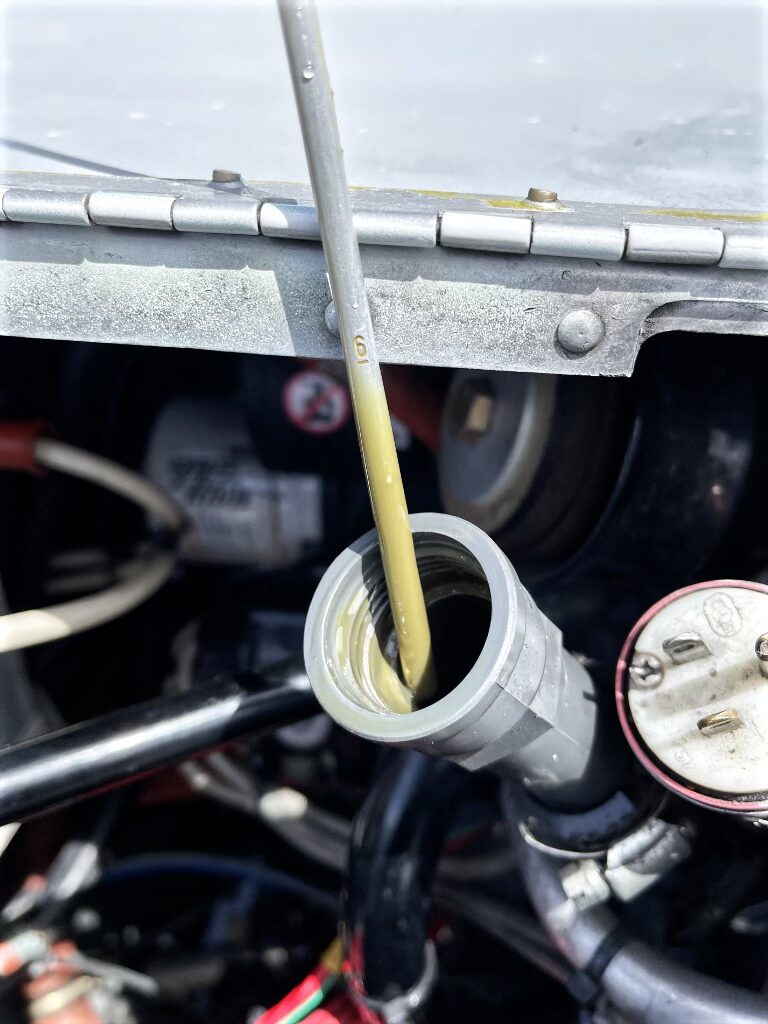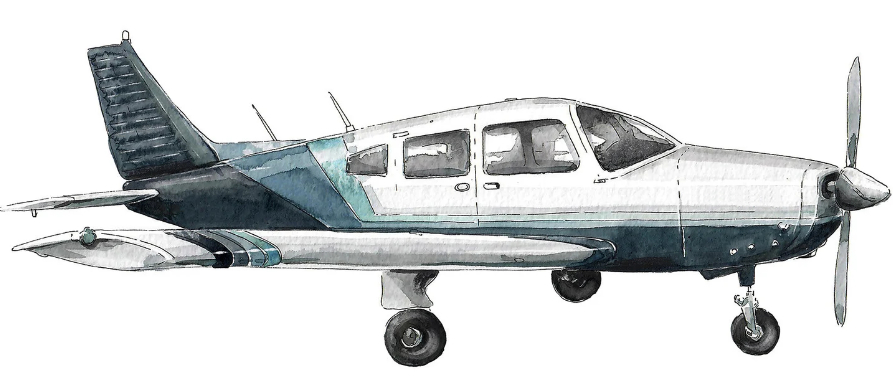
Overview
The Piper Warrior is a popular light aircraft in the Piper PA-28 Cherokee family, commonly used for flight training, personal use, and general aviation.
The Piper Warrior is a single-engine, fixed gear monoplane of all metal construction with low semi-tapered wings.
The Piper PA-28 family, to which the Warrior belongs, was introduced in 1961 by Piper Aircraft as a series of light aircraft aimed at both flight training and personal use. The series includes several models like the Cherokee, Archer, and Dakota. The Warrior itself was introduced in 1974 as a refinement of earlier PA-28 models.
The Piper Warrior is widely utilized in flight schools due to its relatively forgiving flight characteristics, durability, and cost-effectiveness for training new pilots. It is also favored by private owners for short to medium-distance personal flights.
- It has four place seating and a baggage capacity of two hundred pounds.
- The primary structure, is of aluminum alloy construction (with the exception of the steel tube engine mount, steel landing gear struts and isolated areas).
- Lightweight plastics are used extensively in the extremities the wing tips, the engine cowling, etc.- and in nonstructural components throughout the airplane.
General Features:
- High Wing Stability: The Warrior has a low-wing design, offering better visibility below the aircraft and a more stable flight experience.
- Fixed Gear: The landing gear is fixed (non-retractable), which simplifies maintenance and operation.
- Controls: It uses a yoke system for control, typical in many general aviation aircraft.
Strengths and Popularity
- Forgiving Flight Characteristics: Its stability and easy handling, especially during takeoff and landing, make it a beginner-friendly aircraft.
- Durability: Built with a focus on longevity, Piper Warriors are durable, with many still in operation decades after their manufacture.
- Cost-Effective: The Warrior’s fixed gear reduces complexity and maintenance costs compared to retractable-gear aircraft.
- Versatility: Ideal for both training and personal flying, with enough space to carry up to four people and luggage, making it suitable for short cross-country flights.
- Instructor Favorite: Flight schools use the Warrior for its consistent and reliable performance under the hands of many different pilots.
Key milestones in the Warrior’s development:
- 1974: Introduction of the PA-28-151 Warrior, an update to the Cherokee 140. This model was equipped with a 150-horsepower Lycoming O-320-E3D engine.
- 1977: The PA-28-161 Warrior II replaced the 151, featuring an improved 160-horsepower Lycoming O-320-D3G engine, enhancing performance.
- 1982 and onward: Continuous updates were made, focusing on avionics, fuel systems, and overall performance. Later models like the Warrior III (PA-28-161) brought more modern avionics and slight refinements in aerodynamics and cockpit comfort.
The Warrior quickly became a staple for flight schools worldwide due to its forgiving handling characteristics, making it an ideal aircraft for training novice pilots.
Technical Specifications (PA-28-161 Warrior II/III)
- Seats: 4 (including the pilot)
- Powerplant:
- Engine: Lycoming O-320-D3G
- Horsepower: 160 hp
- Fuel type: 100LL Avgas
- Fuel capacity: Approx. 50 gallons (usable fuel is slightly less, around 48 gallons)
- Performance:
- Maximum speed: 127 knots (146 mph or 235 km/h)
- Cruise speed: 115 knots (132 mph or 213 km/h) at 75% power
- Range: Up to 525 nautical miles (with reserves)
- Service ceiling: 11,000 feet (3,353 m)
- Rate of climb: Approximately 700 feet per minute
- Dimensions and Weight:
- Length: 23 feet 3 inches (7.09 m)
- Wingspan: 35 feet 6 inches (10.82 m)
- Height: 7 feet 3 inches (2.21 m)
- Empty weight: 1,600 lbs (726 kg)
- Maximum takeoff weight (MTOW): 2,440 lbs (1,107 kg)
- Useful load: 840 lbs (381 kg)
- Baggage capacity: Around 200 lbs (90 kg)
- Landing Gear and Flaps:
- Landing Gear: Fixed tricycle gear (no retraction mechanism).
- Flaps: Manually operated, allowing for maximum flap deflection of 40 degrees.
- Avionics:
- ECAC models use analog instruments, however many modern Warrior IIIs are often equipped with advanced avionics such as Garmin G1000 or other modern flight management systems (FMS), digital autopilot, and GPS navigation.
- Most models come standard with a traditional six-pack instrument layout: airspeed indicator, attitude indicator, altimeter, turn coordinator, heading indicator, and vertical speed indicator.
Parts of the Piper Warrior
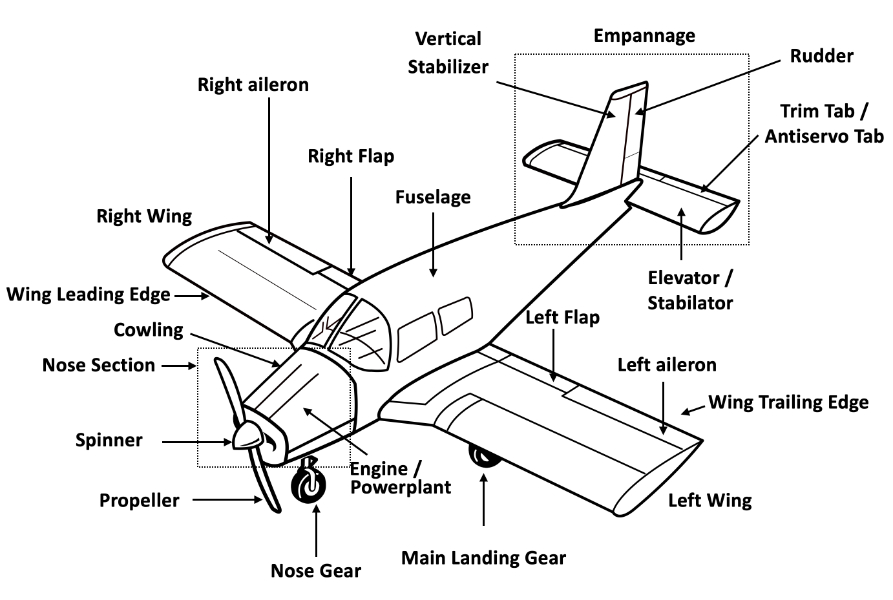
Nose Section
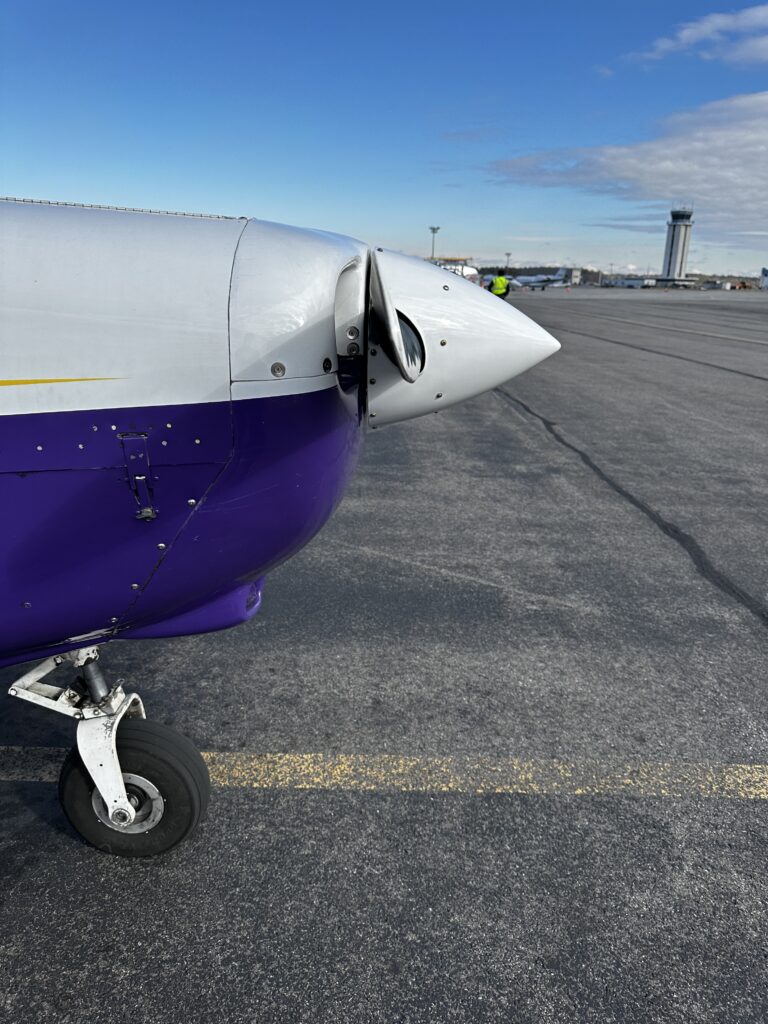
- Propeller: Converts rotational energy from the engine into thrust. The propeller connect to the engine through the hub.
- Spinner: The cone-shaped cover that improves aerodynamics by reducing drag and houses the propeller mounting
- Cowling: The removable covering of an aircraft engine. It serves several important purposes, including aerodynamics, engine cooling, and maintenance accessibility.
- Engine: The power source for an aircraft, converting fuel into mechanical energy to generate thrust. Airplane engines come in various types, each with distinct mechanisms and applications. In training aircraft the engine is a piston engine that operate in a similar way to those used for most cars.
Wings
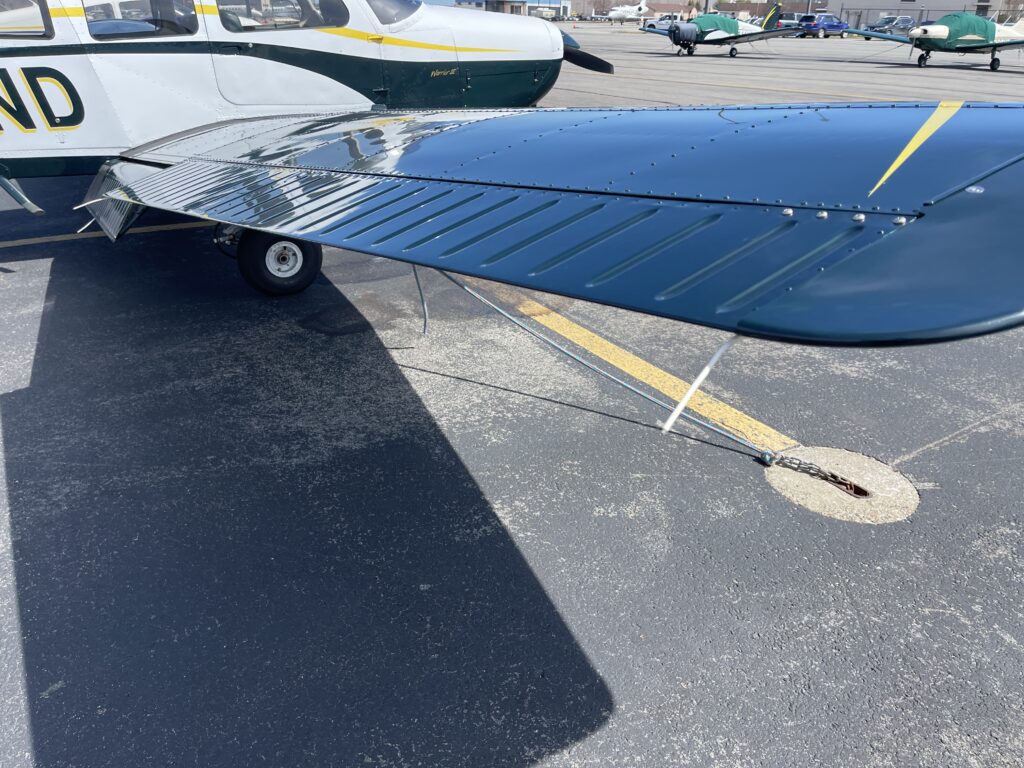
- Airplane wings are responsible for generating lift and allowing it to fly. They come in various designs and configurations depending on the type of aircraft and its intended use.
- Leading Edge: The leading edge is the front part of the wing that first meets the oncoming air. It plays a crucial role in aerodynamics, lift generation, and the overall performance of the aircraft.
- Trailing Edge: The trailing edge is the rear part of the wing where the airflow over the upper and lower surfaces converges. It plays a critical role in controlling the aircraft and optimizing its aerodynamic performance.
- Ailerons: Ailerons are located on the trailing edges of an airplane’s wings, typically near the wingtips. They play a significant role in controlling the aircraft’s roll, which is essential for turning and overall maneuverability. Ailerons control the roll of an aircraft by creating differential lift between the wings. When the pilot moves the control yoke or stick left or right, one aileron deflects upward while the other deflects downward.
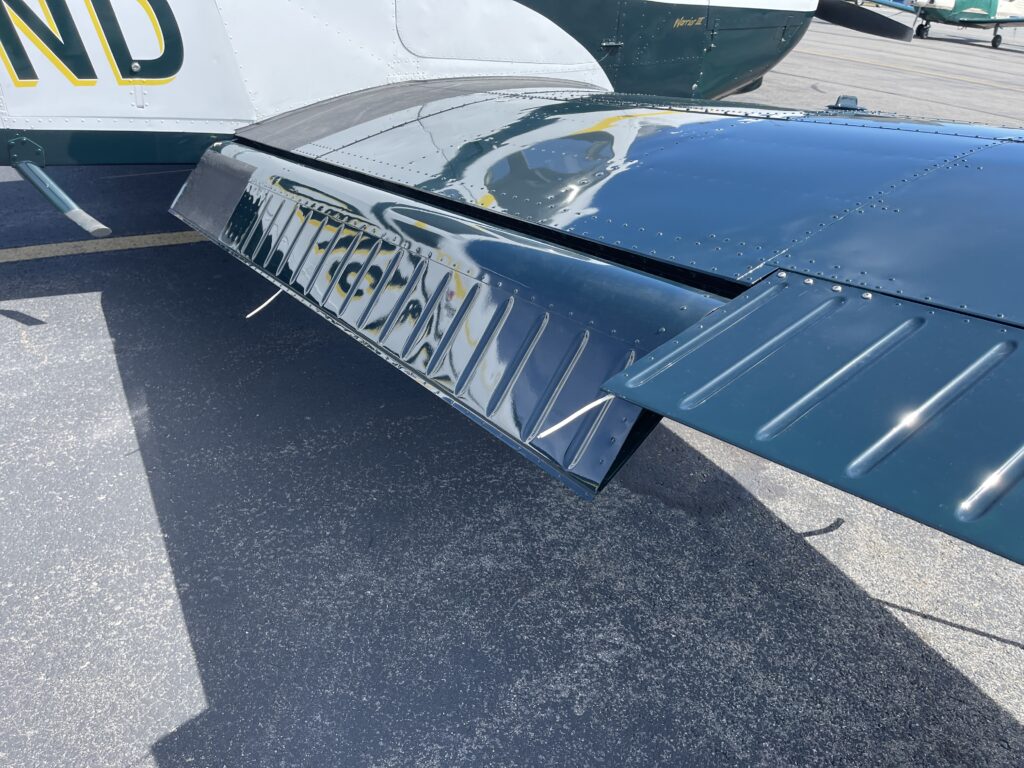
- Flaps: Flaps are movable surfaces located on the trailing edge of the wings. They play a crucial role in enhancing the aircraft’s lift during takeoff and landing, allowing for lower speeds and shorter runway requirements. When extended and change the wing’s shape, increasing its surface area and curvature (camber), which enhances lift. While flaps increase lift, they also increase drag, which helps slow the aircraft down during landing. By increasing drag, flaps allow for a steeper descent angle without increasing airspeed, aiding in landing on shorter runways.
The flaps on most training aircraft are plain flaps that hinge downward from the trailing edge of the wing.
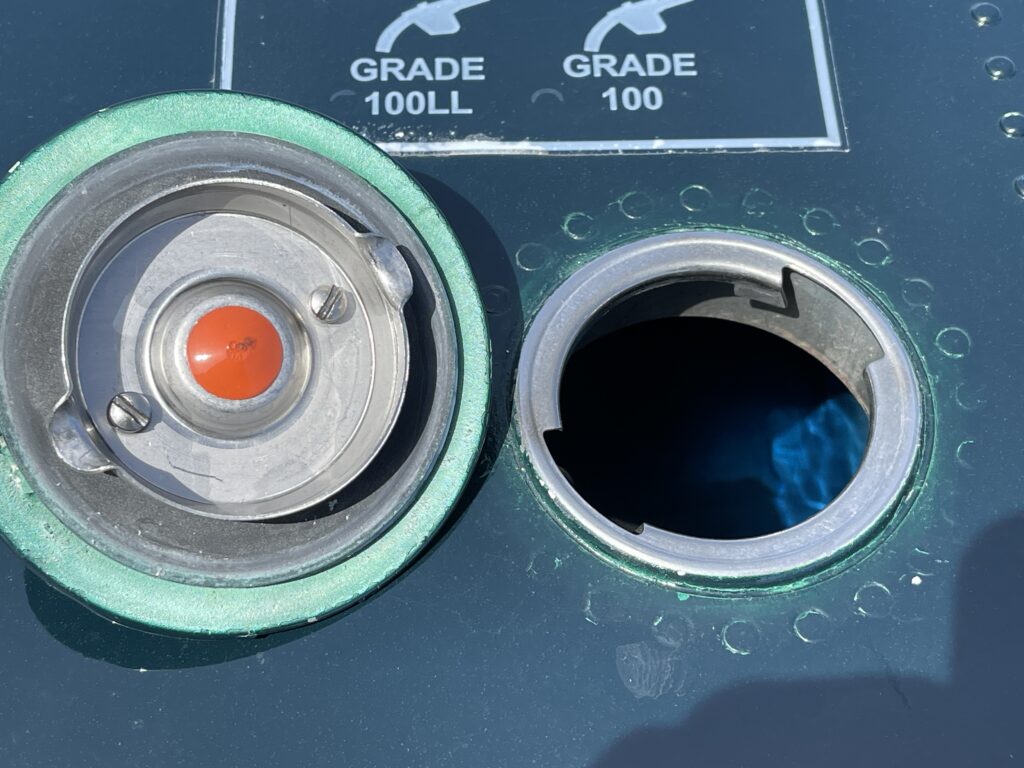
- Fuel Tanks: The Piper Warrior, has its fuel tanks integrated into its wings and has a total fuel capacity of around 50 gallons, with each wing tank holding approximately 25 gallons about 48 gallons are usable. The small amount of unusable fuel (about 2 gallons) that remains in the tanks and cannot be used by the engine. This placement helps with weight distribution and aircraft balance.
Fuselage
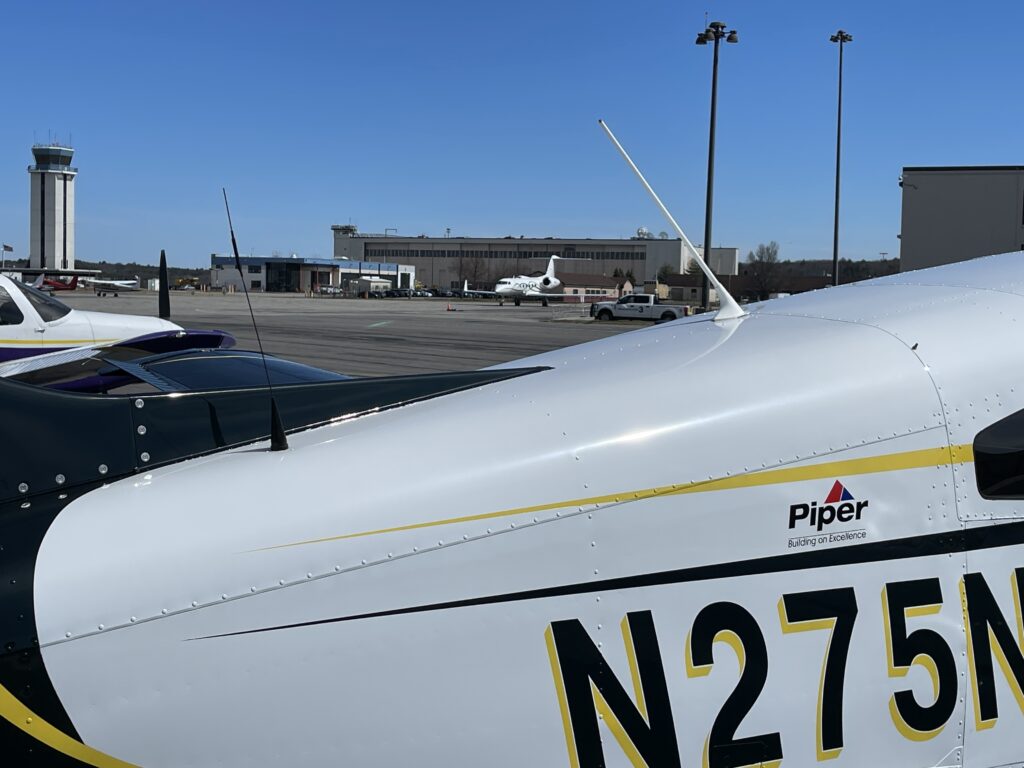
The fuselage is the main body of an aircraft, serving as the central structure to which the wings, tail, and landing gear are attached. It houses the cockpit, passenger cabin, cargo hold, and other critical components. The fuselage structure is a conventional semi-monocoque structure that combines a stressed skin with an internal framework of stringers and frames to distribute loads more effectively. This is the most common type in modern aircraft.
Empennage:
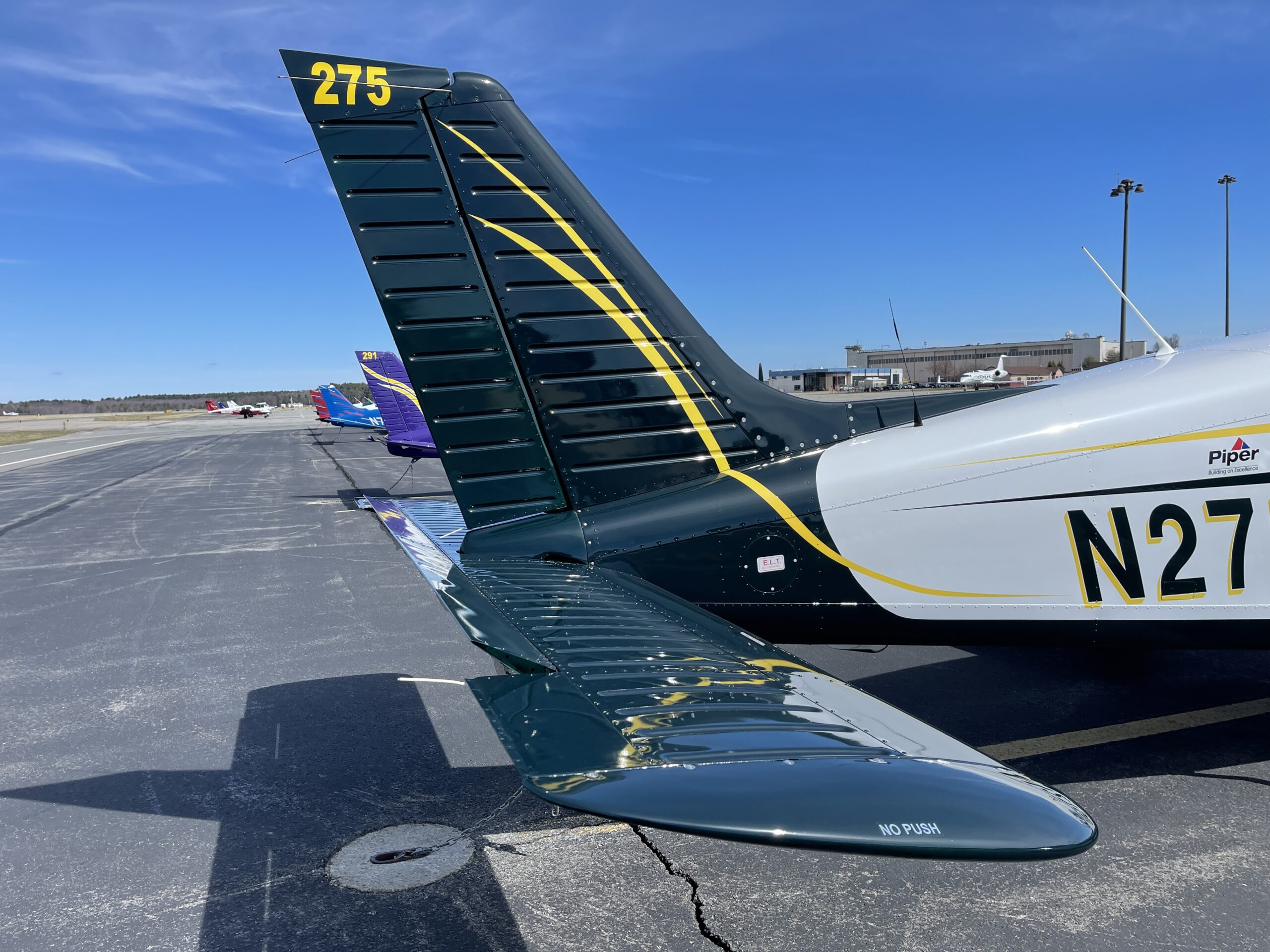
- The empennage, often referred to as the “tail assembly” of an airplane comprises several parts that work together to ensure the aircraft maintains proper flight dynamics and balance.
- Rudder: The rudder is hinged surface located on the trailing edge of the vertical stabilizer. The rudder controls yaw by moving left and right, which directs the aircraft’s nose in the desired direction.
- Stabilator: (Elevator) The stabilator is a hinged aerofoil / surface located on the trailing edge of the horizontal stabilizer. The stabilator controls pitch by moving up and down, which changes the angle of attack of the stabilator.
- Trim Tab: (antiservo tab) The trim tab is small adjustable surface on the trailing edge of the stabilator which is used to relieve control pressures. The trim tab allows for fine adjustments to the control surfaces to maintain the desired flight attitude without constant control input from the pilot.
- Vertical Stabilizer: The vertical stabilizer is a fixed vertical surface mounted on the tail of the aircraft. It provides stability around the vertical axis (yaw). It helps prevent unwanted yawing or side-to-side motion.
Wheels
The Piper Warrior has a tricycle landing gear configuration. One wheel at the nose section and two main landing gear wheels under each wing.
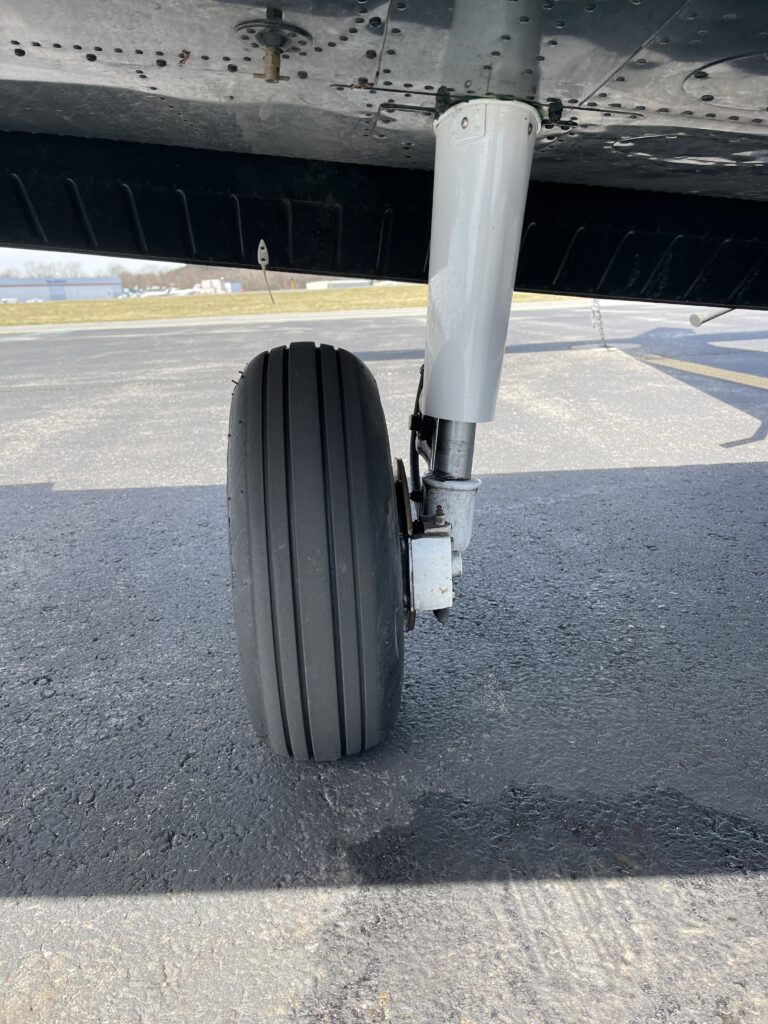
- Main Landing Gear (wheels) The main landing gear of an airplane is a critical component designed to support the aircraft during landing and takeoff, as well as while taxiing. On a Piper Warrior they are located under the wings and consists of several key elements.
- Main Gear Struts: support the wheels and absorb shock. They usually consist of a telescoping design with hydraulic or pneumatic shock absorbers.
- Shock Absorbers: are integrated into the main gear struts to dampen and absorb the forces encountered during landing. Typically hydraulic or oleo-pneumatic systems that use a combination of oil and air pressure.
- Wheels and Tires: Provide the contact point with the ground and are equipped with tires designed to handle the stresses of landing and provide traction.
- Brakes: Equipped on the wheels to help slow down and stop the aircraft after landing. Disc brakes are used on Piper Warrior and use a hydraulic system for breaking.
Nose Gear / Nose Wheel
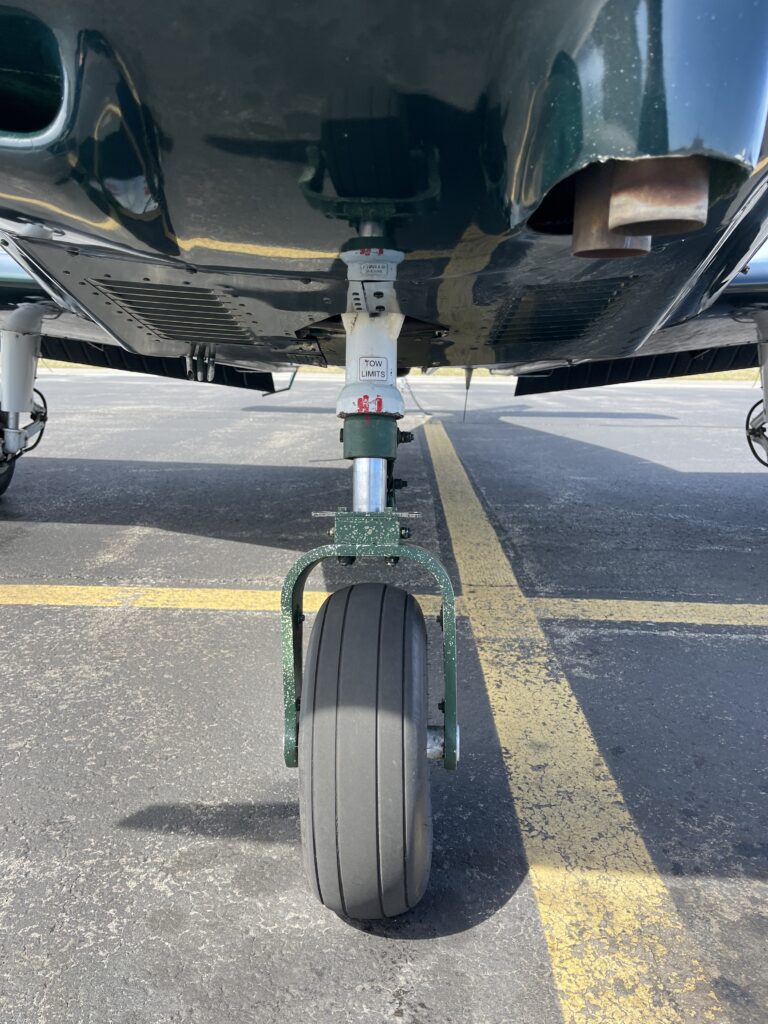
- The nose wheel of the Piper Warrior, is part of the aircraft’s tricycle landing gear configuration. The nose wheel provides the following functions:
- Steering: The nose wheel allows the pilot to steer the aircraft on the ground, providing control during taxiing, takeoff, and landing.
- Shock Absorption: It absorbs the impact forces experienced during landing and helps in smoothing out the ride during ground operations.
- Weight Distribution: Supports the front of the aircraft and helps distribute weight evenly across the landing gear system.
Primary Flight Controls
An airplane’s primary flight controls are the essential components of an aircraft’s flight control system that directly manage the aircraft’s movement and stability. They allow the pilot to control the aircraft’s orientation in three axes: pitch, roll, and yaw. The three primary flight controls and their associated control surfaces are:
Ailerons (Roll Control)
- Location: Mounted on the trailing edge of each wing.
- Function: Ailerons control roll, which is the rotation of the aircraft around its longitudinal axis (nose-to-tail axis). Moving the control stick or yoke to the left or right deflects the ailerons in opposite directions, causing the aircraft to roll left or right.
- Purpose: This movement banks the aircraft for turns.
Elevator / Stabilator (Pitch Control)
- Location: Attached to the trailing edge of the horizontal stabilizer on the aircraft’s tail.
- Function: The elevator controls pitch, the up-and-down movement of the aircraft’s nose, around its lateral axis (wingtip-to-wingtip axis). Pulling the control stick or yoke back raises the elevator, causing the nose to pitch up, while pushing forward lowers the elevator and pitches the nose down.
- Purpose: This affects the aircraft’s angle of attack and altitude.
Rudder (Yaw Control)
- Location: Mounted on the trailing edge of the vertical stabilizer (fin) on the tail.
- Function: The rudder controls yaw, which is the side-to-side movement of the aircraft’s nose around its vertical axis. Pushing the rudder pedals deflects the rudder left or right, causing the aircraft’s nose to yaw in the corresponding direction.
- Purpose: This allows the pilot to maintain coordinated flight during turns or counteract adverse yaw.
These primary flight controls are crucial for the basic maneuvering and handling of an aircraft. They are usually operated through a mechanical, hydraulic, or fly-by-wire system depending on the type of aircraft.
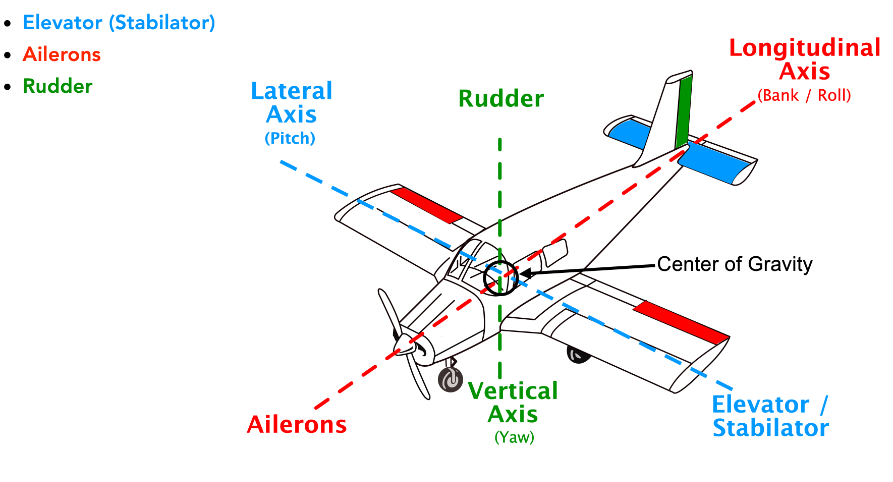
Piper Warrior Engine Bay Components and Parts
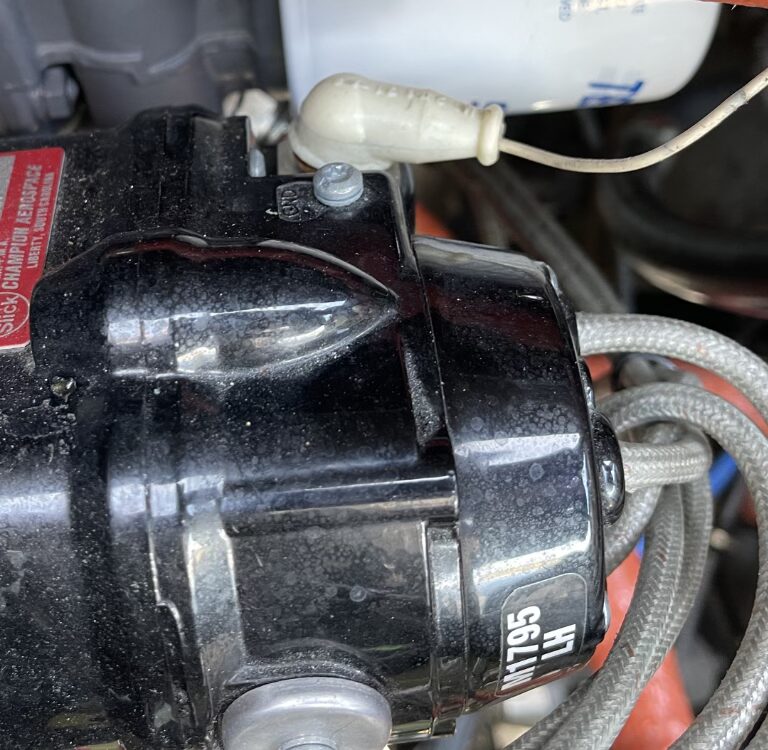
Magento
A magneto is an electromechanical device that provides the electrical energy needed to ignite the fuel-air mixture in aircraft internal combustion engines. They are critical parts in the ignition system, and are mainly used in piston aircraft engines.
The reason magnetos are used is that Magnetos don’t rely on power from the aircraft’s electrical system. If a battery or alternator fails or is turned off, the magnetos continue to supply spark and the aircraft continues to fly
P-Lead
The “P” lead is the white wire shown in the magneto image above. The “P” in P-lead refers to the primary winding in the magneto’s coil. The P-Lead connects a path from the magneto to the aircraft’s ground. This prevents the magneto from send an electrical current to the spark plugs.
To deactivate the magneto, the primary winding is grounded. The keyed ignition switch opens and closes the P-lead circuits to a suitable ground. The internal workings of an Off/R/L/Both ignition switch contain the required connections.
When selected to OFF, both left and right P-leads are grounded and both magnetos are off.
In the LT position, the right P-lead is grounded.
The RT position grounds the left. In Both, both P-lead circuits are open, and both magnetos are on.
Without P-leads, both magnetos would be hot at all times.
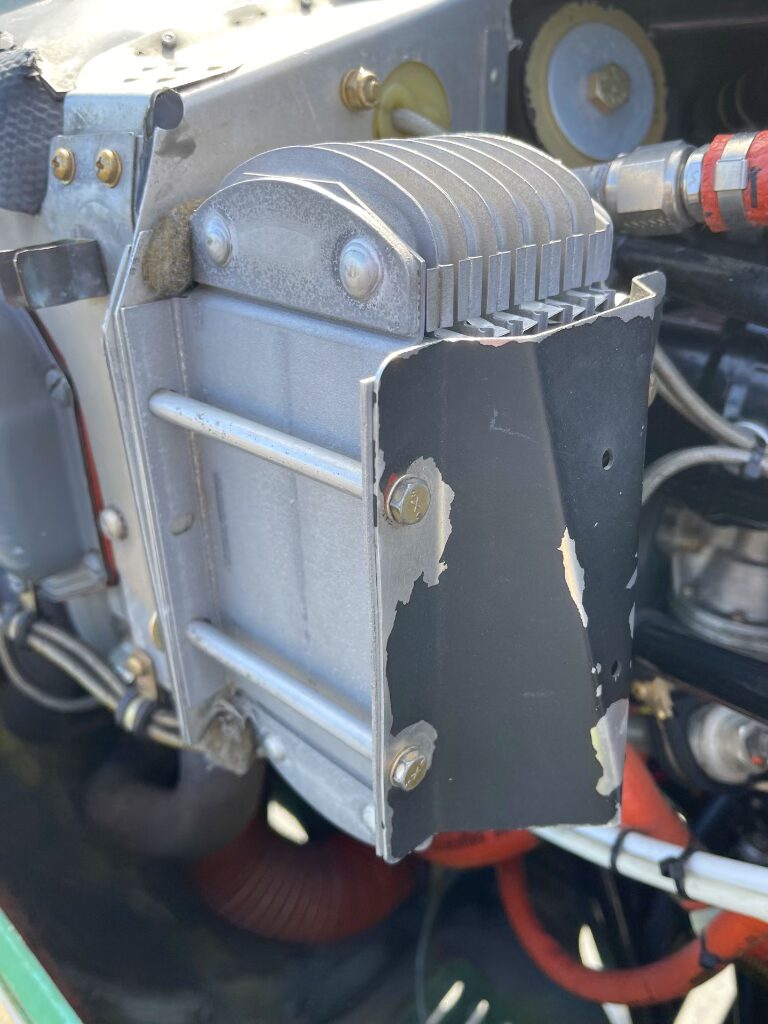
Oil Cooler
Oil Temperature Shown with oil cooler winterization plate. This is to try and keep the oil temperature up to around 180°F. (Green Arc (Normal Operating Range) 100° to 245°F) (Maximum Oil Temperature 245°F)
Oil Pressure Green Arc (Normal Operating Range) 55 to 90 PSI
Oil
Oil Capacity (U.S. quarts) 8
(ECAC standards = 6 quarts for flight
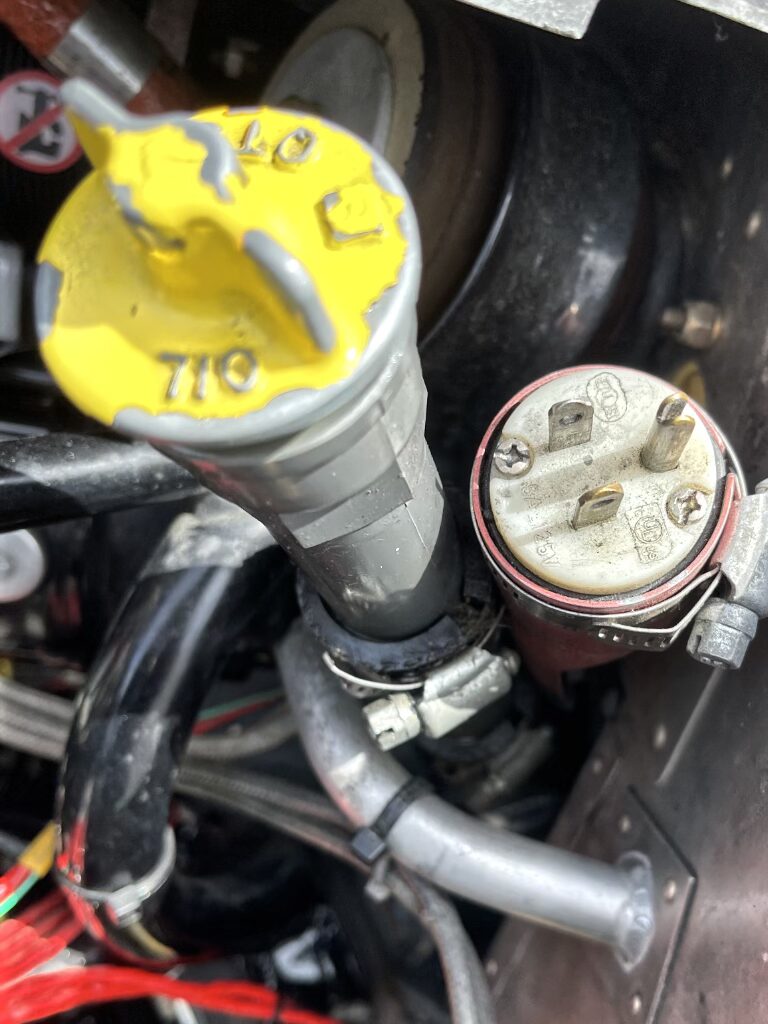
When checking the oil level, make sure that the dipstick has been properly seated when replacing the dipstick. Do not over-tighten.
Oil Specification Refer to latest issue of Lycoming Service Instruction 1014.
(c) Oil Viscosity per Average Ambient Temp. for Starting
Single Multi
Above 60°F S.A.E. 50 S.A.E. 40 or 50
30°F to 90°F S.A.E. 40 S.A.E. 40
0°F to 70°F S.A.E. 30 S.A.E. 40 or 20W-30
Below 10°F S.A.E. 20 S.A.E. 20W-30
